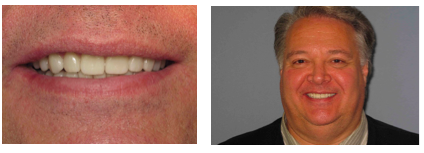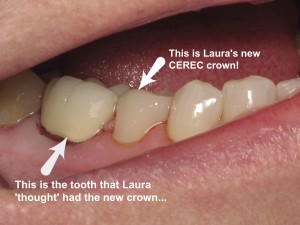By: Dr. Elizabeth Eggert
How did this start?
Tom came to us first as a new patient last summer with a toothache after being referred by co-workers. At the time of his first exam, Tom had many teeth throughout his mouth that had fractured or cracked and he knew things were really broken down. Dr. Elizabeth noted excessive wear throughout his mouth and mild muscle discomfort during the muscle evaluation. Even with our thorough, comprehensive new patient exam, Dr. Elizabeth recommended Tom go through our records process so that she could delve deeper into underlying causes behind his cracking, breaking, and sensitive teeth.
What did Tom want?
Tom had noticed a lot more wear in the last decade and wanted to have them healthy again. He also wanted better looking teeth. He was worried since they looked unhealthy now, what would they look like in 20 years? Specifically, Tom wanted his teeth whiter and more even and wanted things to function better. He had many broken teeth, missing teeth, and wanted a comprehensive plan for restoring his teeth. He was also experiencing some chronic ear/sinus congestion, ringing in ears, and nerve issues in his face that he was hoping to have addressed during the process.

What was revealed during the records process?
Dr. Elizabeth used models, photos, and x-rays of Tom’s teeth along with our thorough muscle and joint evaluation results to present Tom with the current health of his teeth, gums, and the function of his jaw and muscles. The details of the records process revealed that the position of Tom’s teeth caused multiple interferences, so he was biting down unevenly causing the breakdown of his teeth. This deterioration was negatively impacting both the esthetics and function of his teeth. Tom needed a full mouth reconstruction to rebuild what had broken down.
What was involved?
Tom was interested in phasing his treatment to lessen the financial burden. We were able to work with Tom and designed the phased treatment to keep Tom’s teeth, gums, and the function of his jaw and muscles healthy and happy during the process. Dr. Elizabeth worked with a local lab and together designed a blueprint of Tom’s new teeth out of wax. This blueprint is called a laboratory wax-up and it provided the ability for Dr. Elizabeth to create Tom’s new smile.
Tom then spent a day and a half with us while Dr. Elizabeth prepared his front teeth for new crowns and veneers and his back teeth for long-term temporary crowns to get Tom used to more esthetic front teeth and a healthy bite in the back. We finally designed a splint for Tom to wear while he sleeps to protect his new smile from clenching, grinding and his very strong muscles.
What does Tom think?
“Before having it done, I thought it would be a much longer process, more like a year. It went a lot easier than expected. There was not much pain involved and it was helpful to have all of the options. Everything was clear. I’m glad I had it done now and didn’t wait. I think my life will change. I am more confident with my new smile. I would strongly recommend Dr. Elizabeth to others considering getting this done. I don’t know that people make the connection between function and cosmetics, but I sure learned a lot about how things fit together and I love my new smile!”



